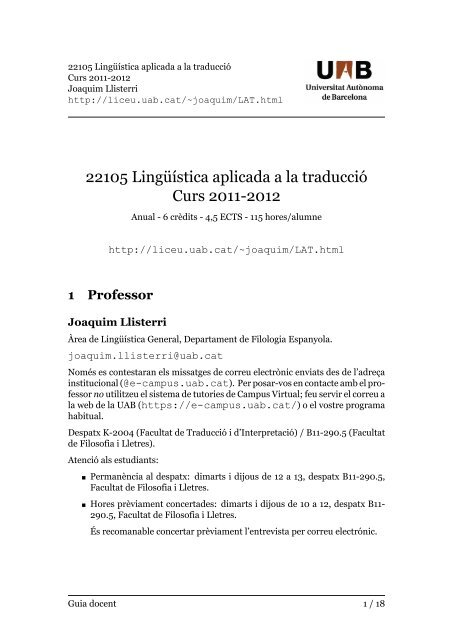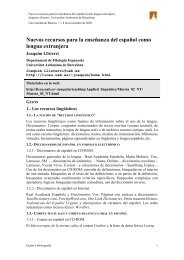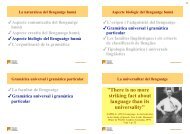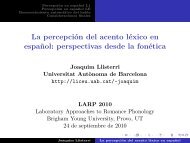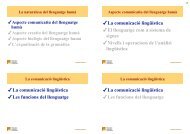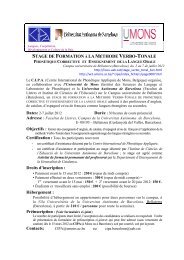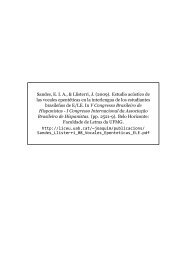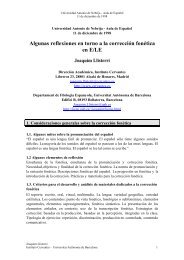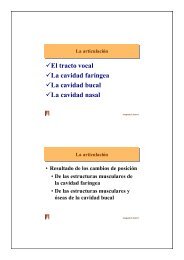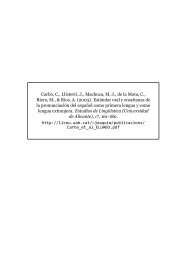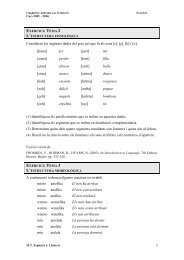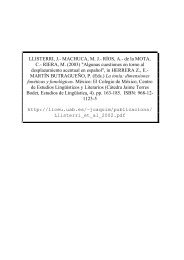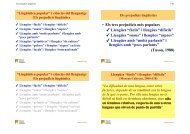Guia docent - Grup de Fonètica
Guia docent - Grup de Fonètica
Guia docent - Grup de Fonètica
You also want an ePaper? Increase the reach of your titles
YUMPU automatically turns print PDFs into web optimized ePapers that Google loves.
22105 Lingüística aplicada a la traducció<br />
Curs 2011-2012<br />
Joaquim Llisterri<br />
http://liceu.uab.cat/~joaquim/LAT.html<br />
22105 Lingüística aplicada a la traducció<br />
Curs 2011-2012<br />
Anual - 6 crèdits - 4,5 ECTS - 115 hores/alumne<br />
http://liceu.uab.cat/~joaquim/LAT.html<br />
1 Professor<br />
Joaquim Llisterri<br />
Àrea <strong>de</strong> Lingüística General, Departament <strong>de</strong> Filologia Espanyola.<br />
joaquim.llisterri@uab.cat<br />
Només es contestaran els missatges <strong>de</strong> correu electrònic enviats <strong>de</strong>s <strong>de</strong> l’adreça<br />
institucional (@e-campus.uab.cat). Per posar-vos en contacte amb el professor<br />
no utilitzeu el sistema <strong>de</strong> tutories <strong>de</strong> Campus Virtual; feu servir el correu a<br />
la web <strong>de</strong> la UAB (https://e-campus.uab.cat/) o el vostre programa<br />
habitual.<br />
Despatx K-2004 (Facultat <strong>de</strong> Traducció i d’Interpretació) / B11-290.5 (Facultat<br />
<strong>de</strong> Filosofia i Lletres).<br />
Atenció als estudiants:<br />
■ Permanència al <strong>de</strong>spatx: dimarts i dijous <strong>de</strong> 12 a 13, <strong>de</strong>spatx B11-290.5,<br />
Facultat <strong>de</strong> Filosofia i Lletres.<br />
■ Hores prèviament concerta<strong>de</strong>s: dimarts i dijous <strong>de</strong> 10 a 12, <strong>de</strong>spatx B11-<br />
290.5, Facultat <strong>de</strong> Filosofia i Lletres.<br />
És recomanable concertar prèviament l’entrevista per correu electrónic.<br />
<strong>Guia</strong> <strong>docent</strong> 1 / 18
22105 Lingüística aplicada a la traducció<br />
Curs 2011-2012<br />
Joaquim Llisterri<br />
http://liceu.uab.cat/~joaquim/LAT.html<br />
2 Objectius <strong>de</strong> la formació<br />
Atès el fet que l’objecte d’estudi <strong>de</strong> la lingüística és el llenguatge i que la traducció<br />
és bàsicament una operació lingüística, l’objectiu fonamental d’aquest curs és<br />
donar una formació lingüística bàsica als futurs professionals <strong>de</strong> la Traducció i<br />
<strong>de</strong> la Interpretació.<br />
L’assignatura té com objectius específics presentar els fonaments i principis <strong>de</strong>l<br />
llenguatge humà, les estructures i l’ús <strong>de</strong> les llengües, i els fonaments lingüístics<br />
<strong>de</strong>l procés <strong>de</strong> traducció.<br />
3 Continguts<br />
3.1 Bloc 1: Fonaments i principis <strong>de</strong>l llenguatge humà<br />
0. Conceptes generals i prejudicis lingüístics<br />
La diversitat <strong>de</strong>l llenguatge. ¿Hi ha llengües millors i pitjors, primitives i<br />
avança<strong>de</strong>s, fàcils i difícils, aspres i dolces, etc.?<br />
1. La naturalesa <strong>de</strong>l llenguatge humà<br />
Aspecte comunicatiu <strong>de</strong>l llenguatge humà. La comunicació lingüística. Les funcions<br />
<strong>de</strong>l llenguatge. El llenguatge humà com a sistema <strong>de</strong> signes. El signe lingüístic.<br />
Relacions d’oposició: paradigmàtiques i sintagmàtiques. La doble articulació<br />
<strong>de</strong>l llenguatge humà. Nivells i operacions <strong>de</strong> l’anàlisi lingüística.<br />
Aspecte creatiu <strong>de</strong>l llenguatge humà. El llenguatge humà com a sistema <strong>de</strong> coneixement.<br />
Llenguatge: activitat i forma.<br />
Aspecte biològic <strong>de</strong>l llenguatge humà. L’origen i l’adquisició <strong>de</strong>l llenguatge. Gramàtica<br />
universal i gramàtica particular. Les famílies lingüístiques i els criteris<br />
<strong>de</strong> classificació. Tipologia lingüística i universals lingüístics.<br />
L’organització <strong>de</strong> la gramàtica.<br />
<strong>Guia</strong> <strong>docent</strong> 2 / 18
22105 Lingüística aplicada a la traducció<br />
Curs 2011-2012<br />
Joaquim Llisterri<br />
http://liceu.uab.cat/~joaquim/LAT.html<br />
3.2 Bloc 2: Les estructures <strong>de</strong> les llengües<br />
2. L’estructura fonètica i l’estructura fonològica<br />
Llengua oral i llengua escrita. Sistemes <strong>de</strong> representació gràfica <strong>de</strong> la llengua.<br />
Les relacions entre sons i grafies. Caracterització articulatòria <strong>de</strong>ls elements<br />
segmentals. Els elements suprasegmentals. La transcripció fonètica: els alfabets<br />
fonètics.<br />
Les unitats <strong>de</strong> l’anàlisi fonològica: fonemes i trets distintius.<br />
3. L’estructura morfològica i el significat lèxic<br />
Les unitats <strong>de</strong> l’anàlisi morfològica: mot, morfema, morf i al.lomorf. Processos<br />
morfològics: flexió, <strong>de</strong>rivació i composició.<br />
Les tipologies morfològiques: llengües aïllants, aglutinants i flexives.<br />
Relacions <strong>de</strong> sentit entre unitats lèxiques: contrastos binaris (antonímia, complementarietat,<br />
inversió), contrastos no binaris, hiponímia i sinonímia, polisèmia<br />
i homonímia, implicació.<br />
Significat central i significat perifèric: extensions figuratives. Metàfores i metonímies.<br />
Camps semàntics o conceptuals i camps lèxics.<br />
L’estructuració <strong>de</strong>l lèxic. Lèxic heretat, lèxic adquirit i lèxic creat.<br />
Lèxic, lexicó i diccionari. Terminologia.<br />
4. L’estructura sintàctica<br />
Gramaticalitat i correcció. Gramàtica <strong>de</strong>scriptiva i gramàtica normativa.<br />
Les unitats <strong>de</strong> l’anàlisi sintàctica: constituent, sintagma, oració. L’estructura<br />
sintàctica com a estructura jeràrquica: ordre lineal i ordre estructural.<br />
Categories gramaticals: categories lèxiques i sintàctiques. Categories lèxiques:<br />
les parts <strong>de</strong> l’oració. Categories sintàctiques: sintagmes o frases. Les funcions<br />
sintàctiques. Arguments i adjunts.<br />
Ordre bàsic <strong>de</strong>ls constituents <strong>de</strong> l’oració. Tema i rema: passiva, dislocació, interrogació<br />
i focalització.<br />
<strong>Guia</strong> <strong>docent</strong> 3 / 18
22105 Lingüística aplicada a la traducció<br />
Curs 2011-2012<br />
Joaquim Llisterri<br />
http://liceu.uab.cat/~joaquim/LAT.html<br />
Tipologia sintàctica.<br />
5. L’estructura semàntica<br />
El significat estrictament lingüístic i la interpretació d’enunciats. Significat <strong>de</strong>l<br />
mot i significat <strong>de</strong> l’oració.<br />
La composicionalitat <strong>de</strong>l significat. Relacions estructurals: relacions temàtiques<br />
o <strong>de</strong> predicació; relacions <strong>de</strong> modificació i <strong>de</strong> quantificació.<br />
Contingut proposicional i relacions <strong>de</strong> sentit entre proposicions: implicació,<br />
pressuposició, paràfrasi, oposició, contradicció, anomalia, ambigüitat i vaguetat.<br />
El significat discursiu. Relacions interoracionals: connexió formal, cohesió lèxica,<br />
connexió discursiva. La noció <strong>de</strong> coherència en la formació <strong>de</strong>l text.<br />
3.3 Bloc 3: L’ús <strong>de</strong> les llengües<br />
6. L’actuació lingüística<br />
Comunicació verbal i comprensió d’enunciats. Aspectes cognitius i socials associats<br />
amb l’ús <strong>de</strong>l llenguatge.<br />
Els actes <strong>de</strong> parla.<br />
Informació explícita i informació implícita en l’ús <strong>de</strong>l llenguatge. Implicatures i<br />
pressuposicions pragmàtiques.<br />
La noció <strong>de</strong> context. La dixi. El context i la noció d’entorn cognoscitiu. El<br />
problema <strong>de</strong> l’accessibilitat <strong>de</strong> la informació.<br />
7. La variació lingüística<br />
Variació en la comunitat lingüística: llengua, dialecte, subdialecte i idiolecte.<br />
La variació estilística i els registres lingüístics. La variació social. La variació<br />
històrica. La variació geogràfica.<br />
Llengua estàndard. Llengua oficial. Traducció i normalització lingüística.<br />
Llengua franca, pidgins i criolls.<br />
<strong>Guia</strong> <strong>docent</strong> 4 / 18
22105 Lingüística aplicada a la traducció<br />
Curs 2011-2012<br />
Joaquim Llisterri<br />
http://liceu.uab.cat/~joaquim/LAT.html<br />
3.4 Bloc 4: El procés <strong>de</strong> traducció<br />
8. La traducció<br />
El llenguatge com a vehicle cultural en el camp <strong>de</strong> la traducció.<br />
Traducció intralingüística i traducció interlingüística. Llengua font i llengua terminal.<br />
Traducció: fase interpretativa i fase comunicativa. La doble interpretació<br />
en el procés <strong>de</strong> traducció: la interpretació <strong>de</strong>l traductor i la <strong>de</strong>l receptor final <strong>de</strong>l<br />
missatge. Procés <strong>de</strong> transcodificació: codi. Procés <strong>de</strong> traducció: context. Unitat<br />
<strong>de</strong>l procés <strong>de</strong> traducció: el discurs vs. la forma proposicional.<br />
El problema <strong>de</strong> l’equivalència: contingut, estil i aspectes formals. Correspondència<br />
formal i equivalència dinàmica. Traducció i pertinència.<br />
Context i traducció: el treball <strong>de</strong> documentació. L’estoc <strong>de</strong> coneixements <strong>de</strong>l<br />
traductor-intèrpret.<br />
4 Bibliografia<br />
4.1 Manuals<br />
Per a la preparació <strong>de</strong>l programa <strong>de</strong> l’assignatura es recomana que els estudiants<br />
seleccionin i utilitzin regularment com a bibliografia bàsica un <strong>de</strong>ls set manuals<br />
següents:<br />
4.1.1<br />
Akmajian, A., Demers, R. A., Farmer, A. K., i Harnish, R. M. (2010). Linguistics:<br />
An introduction to language and communication (6th ed.). Cambridge, MA:<br />
The MIT Press.<br />
[1.- What Is Linguistics?; 2.-Morphology: The Study of the Structure of Words; 3.-<br />
Phonetics and Phonemic Transcription; 4.- Phonology: The Study of Sound Structure;<br />
5.- Syntax: The Study of Sentence Structure; 6.- Semantics: The Study of Linguistic<br />
Meaning; 7.- Language Variation; 8.- Language Change; 9.- Pragmatics: The<br />
Study of Language Use and Communication; 10.- Psychology of Language: Speech<br />
Production and Comprehension; 11.- Language Acquisition in Children; 12.- Language<br />
and the Brain; Appendix - The Written Representation of Language.]<br />
<strong>Guia</strong> <strong>docent</strong> 5 / 18
22105 Lingüística aplicada a la traducció<br />
Curs 2011-2012<br />
Joaquim Llisterri<br />
http://liceu.uab.cat/~joaquim/LAT.html<br />
Akmajian, A., Demers, R. A., i Harnish, R. M. (1992). Linguistics: An introduction<br />
to language and communication (3rd ed.). Cambridge, MA: The MIT<br />
Press.<br />
[1.- What is linguistics?; 2.- Animal communication; 3.- Morphology: The structure<br />
of words; 4.- Phonology: The structure and the patterning of the sounds of language;<br />
5.- Syntax: The study of sentence structure; 6.- Semantics: The study of meaning and<br />
reference; 7.- Language variation; 8.- Language change; 9.- Pragmatics; The study of<br />
language use and communication; 10.- Psychology of language: Speech production<br />
and comprehension; 11.- Language acquisition in child and chimp; 12.- Language and<br />
the brain.]<br />
Traducció castellana <strong>de</strong> la primera edició: Akmajian, A., Demers, R. A., i Harnish,<br />
R. M. (1984). Lingüística: Una introducción al lenguaje y a la comunicación.<br />
Madrid: Alianza.<br />
[1.- ¿Qué es la lingüística?; 5.- Comparación <strong>de</strong> los sistemas <strong>de</strong> comunicación animal;<br />
6.- Fonología: La estructura <strong>de</strong> los sonidos; 7.- Morfología: La estructura <strong>de</strong> las<br />
palabras; 8.- Sintaxis: El estudio <strong>de</strong> la estructura <strong>de</strong> la oración; 9.- La variación en<br />
el lenguaje; 11.- Semántica: Estudio <strong>de</strong>l significado y <strong>de</strong> la referencia; 12.- Pragmática:<br />
El estudio <strong>de</strong>l uso <strong>de</strong>l lenguaje y la comunicación lingüística; 13.- Lenguaje y<br />
cerebro.]<br />
4.1.2<br />
Escan<strong>de</strong>ll, M. V., Marrero, V., Casado, C., Gutiérrez Rodríguez, E., i Ruiz-Va,<br />
P. (2009). El lenguaje humano. Madrid: Editorial Universitaria Ramón Areces.<br />
4.1.3<br />
Fasold, R. W., i Connor-Linton, J. (2006). An introduction to language and<br />
linguistics. Cambridge: Cambridge University Press.<br />
Material complementari:<br />
http://dx.doi.org/10.2277/0521612357<br />
[Introduction: Ralph W. Fasold and Jeff Connor-Linton; 1.- The sounds of language:<br />
Elizabeth Zsiga; 2.-Words and their parts; Donna Lardiere; 3.- The structure of sentences:<br />
David Lightfoot and Ralph Fasold; 4.- Meaning: Paul Portner; 5.- Discourse:<br />
Deborah Schiffrin; 6.- Child language acquisition: Kendall A. King; 7.- Langua-<br />
<strong>Guia</strong> <strong>docent</strong> 6 / 18
22105 Lingüística aplicada a la traducció<br />
Curs 2011-2012<br />
Joaquim Llisterri<br />
http://liceu.uab.cat/~joaquim/LAT.html<br />
ge and the brain: Michael Ullman; 8.- Language change: Shaligram Shukla and Jeff<br />
Connor-Linton; 9.- Dialect variation: Natalie Schilling-Estes; 10.- Language and culture:<br />
Deborah Tannen; 11.- The politics of language: Ralph W. Fasold; 12.- Writing:<br />
Jeff Connor-Linton; 13.- Second language acquisition: Alison Mackey; 14.- Computational<br />
linguistics: In<strong>de</strong>rjeet Mani.]<br />
4.1.4<br />
Finegan, E. (2008). Language: Its structure and use (5th ed.). Boston, MA:<br />
Heinle.<br />
Material complementari:<br />
http://www.heinle.com/cgi-wadsworth/course_<br />
products_wp.pl?fid=M20bI&flag=instructor&product_<br />
isbn_issn=1413030890&discipline_number=<br />
300&template=AISE<br />
[1.- Languages and Linguistics; 2.- Words and Their Parts: Lexicon and Morphology;<br />
3.- The Sounds of Languages: Phonetics; 4.- Sound Systems of Language: Phonology;<br />
5.- The Structure and Function of Phrases and Sentences: Syntax; 6.- The Study of<br />
Meaning: Semantics; 7.- Language Universals and Language Typology; 8.- Information<br />
Structure and Pragmatics; 9.- Speech Acts and Conversation; 10.- Language Variation<br />
across Situations of Use; 11.- Language Variation among Social Groups: Dialects;<br />
12.- Writing; 13.- Language Change over Time: Historical Linguistics: 14.- Historical<br />
Development in English; 15.- Acquiring First and Second Languages.]<br />
Finegan, E., i Besnier, N. (1989). Language: Its structure and use. New York:<br />
Harcourt Brace Jovanovich.<br />
[1.- Language structure and language use; 2.- Phonetics: The sounds of language; 3.-<br />
Phonology: The sound systems of language; 4.- Morphology: Structured meaning<br />
in Words; 5.- Syntax: Sentences and their structure; 6.- Semantics: Word meaning<br />
and sentence meaning; 7.- Pragmatics: Information structure; 8.- Language universals<br />
and language typology; 9.- The historical <strong>de</strong>velopment of languages; 10.- Speech<br />
acts and conversation; 11.- Writing; 12.- Dialects: Linguistic variation among social<br />
groups; 13.- Registers: Language variation in situations of use; 14.- The historical<br />
<strong>de</strong>velopment of English; 15.- Language standards and language attitu<strong>de</strong>s.]<br />
<strong>Guia</strong> <strong>docent</strong> 7 / 18
22105 Lingüística aplicada a la traducció<br />
Curs 2011-2012<br />
Joaquim Llisterri<br />
http://liceu.uab.cat/~joaquim/LAT.html<br />
4.1.5<br />
Fromkin, V., Rodman, R., i Hyams, N. (2011). An introduction to language (9th<br />
ed.). Boston, MA: Heinle.<br />
Material complementari:<br />
http://www.cengage.com/cgi-wadsworth/course_<br />
products_wp.pl?fid=M20bI&product_isbn_issn=<br />
9781428263925<br />
[1.- What Is Language?; 2.- Brain and Language; 3.- Morphology: The Words of Language;<br />
4.- Syntax: The Sentence Patterns of Language; 5.- The Meaning of Language;<br />
6.- Phonetics: The Sounds of Language; 7.- Phonology: The Sound Patterns of Language;<br />
8.- Language Acquisition; 9.- Language Processing: Humans and Computers;<br />
10.- Language in Society; 11.- Language Change: The Syllables of Time; 12.- Writing:<br />
The ABCs of Language.]<br />
Fromkin, V., i Rodman, R. (1998). An introduction to language (6th ed.). Fort<br />
Worth: Harcourt Brace College Publishers.<br />
[1.- What is Language?; 2.- The Neurobiology of Language; 3.- Morphology: The<br />
Words of Language; 4.- Syntax: The Sentence Patterns of Language; 5.- Semantics<br />
and Pragmatics: Meanings and Context; 6.- Phonetics: The Sounds of Language; 7.-<br />
Phonology: The Sound Patterns of Language; 8.- The Acquisition of Language; 9.-<br />
Language Processing; 10.- Social Aspects of Language; 11.- Language Change: Syllable<br />
of Time.]<br />
4.1.6<br />
O’Grady, W., Archibald, J., Aronoff, M., i Rees-Miller, J. (2010). Contemporary<br />
linguistics. An introduction (6th ed.). Boston, MA: Bedford / St Martin’s.<br />
Material complementari:<br />
http://bcs.bedfordstmartins.com/linguistics6e/<br />
[1.- Language: A Preview; 2.- Phonetics: The Sounds of Language; 3.- Phonology:<br />
The Function and Patterning of Sounds; 4.- Morphology: The Analysis of Word<br />
Structure; 5.- Syntax: The Analysis of Sentence Structure; 6.- Semantics: The Analysis<br />
of Meaning; 7.- Historical Linguistics: The Study of Language Change; 8.- The<br />
Classification of Languages; 9.- Indigenous Languages of North America: 10.- First<br />
Language Acquisition; 11.- Second Language Acquisition; 12.- Psycholinguistics: The<br />
Study of Language Processing; 13.- Brain and Language; 14.- Language in Social Con-<br />
<strong>Guia</strong> <strong>docent</strong> 8 / 18
22105 Lingüística aplicada a la traducció<br />
Curs 2011-2012<br />
Joaquim Llisterri<br />
http://liceu.uab.cat/~joaquim/LAT.html<br />
texts; 15.- Natural Sign Languages; 16.- Writing and Language; 17.- Computational<br />
Linguistics.]<br />
O’Grady, W., Dobrovolsky, M., i Aronoff, M. (1997). Contemporary linguistics.<br />
An introduction (3rd ed.). Boston, MA: Bedford / St Martin’s.<br />
[1.- Language a preview; 2.- Phonetics: the sound of language; 3.- Phonology: the<br />
function and patterning of sounds; 4.- Morphology: the analysis of word structure;<br />
5.- Syntax: the analysis of sentence structure; 6.- Interfaces; 7.- Semantics: the<br />
analysis of meaning; 8.- Historical linguistics: the study of language change; 9.- The<br />
classification of languages; 10.- Psycholinguistics: the study of language processing;<br />
11.- Brain and language; 12.- Language Acquisition: the emergence of grammar; 13.-<br />
Second language acquistion; 14.- Language in social contexts; 15.- Writing and language;<br />
16.- Animal communication; 17.- Computational linguistics.]<br />
O’Grady, W., Dobrovolsky, M., i Katamba, F. (1997). Contemporary linguistics.<br />
An introduction. London: Longman.<br />
[1.- Language a preview; 2.- Phonetics: the sound of language; 3.- Phonology: the<br />
function and patterning of sounds; 4.- Morphology: the analysis of word structure;<br />
5.- Syntax: the analysis of sentence structure; 6.- Interfaces; 7.- Semantics: the<br />
analysis of meaning; 8.- Historical linguistics: the study of language change; 9.- The<br />
classification of languages; 10.- Brain and language; 11.- Psycholinguistics: the study<br />
of language processing; 12.- Language Acquisition: the emergence of grammar; 13.-<br />
Second language acquistion; 14.- Language in social contexts; 15.- Writing and language;<br />
16.- Animal communication; 17.- Computational linguistics.]<br />
4.1.7<br />
Radford, A., Atkinson, M., Britain, D., Clahsen, H., i Spencer, A. (2009).<br />
Linguistics: An introduction (2nd ed.). Cambridge: Cambridge University<br />
Press.<br />
[Introduction; Part I. Sounds: 1-. Introduction; 2-. Sounds and suprasegmentals; 3-.<br />
Sound variation; 4-. Sound change; 5-. Phonemes, syllables and phonological processes;<br />
6-. Child phonology; 7-. Processing sounds; Part II. Words: 8-. Introduction;<br />
9-. Word classes; 10-. Building words; 11-. Morphology across languages; 12-. Word<br />
meaning; 13-. Children and words; 14-. Lexical processing and the mental lexicon;<br />
15-. Lexical disor<strong>de</strong>rs; 16-. Lexical variation and change; Part III. Sentences: 17-. Introduction;<br />
18-. Basic terminology; 19-. Sentence structure; 20-. Empty categories;<br />
21-. Movement; 22-. Syntactic variation; 23-. Sentence meanings and logical form;<br />
<strong>Guia</strong> <strong>docent</strong> 9 / 18
22105 Lingüística aplicada a la traducció<br />
Curs 2011-2012<br />
Joaquim Llisterri<br />
http://liceu.uab.cat/~joaquim/LAT.html<br />
24-. Children’s sentences; 25-. Sentence processing; 26-. Syntactic disor<strong>de</strong>rs; 27-.<br />
Using sentences.]<br />
Traducció castellana <strong>de</strong> la primera edició: Radford, A., Atkinson, M., Britain,<br />
D., Clahsen, H., i Spencer, A. (2000). Introducción a la lingüística. Cambridge:<br />
Cambridge University Press.<br />
[Introducción; 1.- Los sonidos: Introducción; 2.- Sonidos y suprasegmentos; 3.- Variaciones<br />
y sonidos; 4.- Cambio fonético; 5.- Fonemas, sílabas y procesos fonológicos;<br />
6.- Fonología infantil; 7.- Procesamiento <strong>de</strong> los sonidos; 8.- Las palabras: Introducción;<br />
9.- Clases <strong>de</strong> palabras; 10.- Construyendo palabras; 11. Las lenguas y su<br />
morfología; 12.- El significado <strong>de</strong> las palabras; 13.- Niños y palabras; 14.- Procesamiento<br />
léxico y léxico mental; 15.- Trastornos léxicos; 16.- Variación y cambio léxicos;<br />
17.- Las oraciones: Introducción; 18.- Terminología básica; 19.- La estructura <strong>de</strong> la<br />
oración; 20.- Categorías vacías; 21.- Movimiento; 22- Variación sintáctica; 23.- Forma<br />
lógica; 24.- Las oraciones <strong>de</strong> los niños; 25.- Procesamiento <strong>de</strong> las oraciones; 26.-<br />
Trastornos sintácticos.]<br />
4.1.8<br />
Els estudiants que necessitin una introducció als conceptes bàsics po<strong>de</strong>n consultar:<br />
Tuson, J. (1991). Lingüística. Una introducción al estudio <strong>de</strong>l lenguaje, con<br />
textos comentados y ejercicios (4a ed.). Barcelona: Barcanova.<br />
[1.- Las señales; 2.- La comunicación y el lenguaje; 3.- El lenguaje y las lenguas; 4.- La<br />
lingüístics y sus objetivos; 5.- La tradición gramatical; 6.- La lingüística estructural;<br />
7.- La gramática generativa y transformacional; 8.- Cómo se organiza una lengua; 9.-<br />
Gramática; 10.- Semántica; 11.- Fonética y fonología; 12.- Las lenguas y las diferencias<br />
culturales; 13.- La lengua y las diferencias sociales y geográficas; 14.- El lenguaje<br />
y la historia; 15.- El lenguaje y la literatura.]<br />
Tuson, J. (1999). Introducció al llenguatge. Barcelona: Edicions Proa - Edicions<br />
<strong>de</strong> la Universitat Oberta <strong>de</strong> Catalunya.<br />
[1.- Els orígens <strong>de</strong>l llenguatge; 2.- El mo<strong>de</strong>l <strong>de</strong> la comunicació i els tipus <strong>de</strong> senyals;<br />
3.- Les llengües <strong>de</strong>l món: diversitat i unitat; 4.- Les varietats lingüístiques i el canvi;<br />
5.- Història <strong>de</strong> la lingüística.]<br />
<strong>Guia</strong> <strong>docent</strong> 10 / 18
22105 Lingüística aplicada a la traducció<br />
Curs 2011-2012<br />
Joaquim Llisterri<br />
http://liceu.uab.cat/~joaquim/LAT.html<br />
4.2 Lectures recomana<strong>de</strong>s<br />
A més <strong>de</strong>ls manuals esmentats, els estudiants han <strong>de</strong> fer les següents lectures, la<br />
comprensió <strong>de</strong> les quals serà objecte d’avaluació:<br />
4.2.1 Tema 0: Conceptes generals i prejudicis lingüístics<br />
Una <strong>de</strong> les dues lectures següents:<br />
(a) Moreno Cabrera, J. C. (2000). Cien mitos, prejuicios y tópicos sobre las lenguas.<br />
A La dignidad e igualdad <strong>de</strong> las lenguas. Crítica <strong>de</strong> la discriminación<br />
lingüística. (p. 237-65). Madrid: Alianza.<br />
(b) Tuson, J. (1991). Mal <strong>de</strong> llengües. A l’entorn <strong>de</strong>ls prejudicis lingüístics<br />
(11ena ed.). Barcelona: Empúries.<br />
Traducció castellana: Tuson, J. (1997). Los prejuicios lingüísticos. Barcelona:<br />
Octaedro.<br />
4.2.2 Tema 1: La naturalesa <strong>de</strong>l llenguatge humà<br />
Els capítols corresponents <strong>de</strong>l manual escollit.<br />
4.2.3 Tema 2: L’estructura fonètica i l’estructura fonològica<br />
Llisterri, J. (1996). Los sonidos <strong>de</strong>l habla. A C. Martín Vi<strong>de</strong> (Ed.), Elementos <strong>de</strong><br />
lingüística. (p. 67-128). Barcelona: Octaedro.<br />
4.2.4 Tema 3: L’estructura mofològica i el significat lèxic<br />
Els capítols corresponents <strong>de</strong>l manual escollit.<br />
4.2.5 Tema 4: L’estructura sintàctica<br />
Hernanz, M. L., i Brucart, J. M. (1987). La sintaxis. A La sintaxis I. Principios<br />
teóricos. La oración simple. (p. 12-47). Barcelona: Crítica.<br />
<strong>Guia</strong> <strong>docent</strong> 11 / 18
22105 Lingüística aplicada a la traducció<br />
Curs 2011-2012<br />
Joaquim Llisterri<br />
http://liceu.uab.cat/~joaquim/LAT.html<br />
Hernanz, M. L., i Brucart, J. M. (1987). La oración. A La sintaxis I. Principios<br />
teóricos. La oración simple. (p. 48-69). Barcelona: Crítica.<br />
Hernanz, M. L., i Brucart, J. M. (1987). El or<strong>de</strong>n básico <strong>de</strong> las palabras en la<br />
oración y sus modificaciones. A La sintaxis I. Principios teóricos. La oración<br />
simple. (p. 70-106). Barcelona: Crítica.<br />
4.2.6 Tema 5: L’estructura semàntica<br />
Una <strong>de</strong> les dues lectures següents:<br />
(a) Espinal, M. T. (1996). El significado. A C. Martín Vi<strong>de</strong> (Ed.), Elementos <strong>de</strong><br />
lingüística. (p. 247-66). Barcelona: Octaedro.<br />
(b) Mateu, J., i Quer, J. (2002). Semàntica I. Predicació i quantificació. A M.<br />
T. Espinal (Ed.), Semàntica. Del significat <strong>de</strong>l mot al significat <strong>de</strong> l’oració. (p.<br />
251-96). Barcelona: Ariel.<br />
Quer, J. (2002). 6.1. Modificació. A M. T. Espinal (Ed.), Semàntica. Del significat<br />
<strong>de</strong>l mot al significat <strong>de</strong> l’oració. (p. 299-313). Barcelona: Ariel.<br />
4.2.7 Tema 6: L’actuació lingüística<br />
Reyes, G. (1996). El abecé <strong>de</strong> la pragmática (2a ed.). Madrid: Arco/Libros.<br />
4.2.8 Tema 7: La variació lingüística<br />
Rotaetxe, K. (1996). Lenguaje y sociedad: Sociolingüística. A C. Martín Vi<strong>de</strong><br />
(Ed.), Elementos <strong>de</strong> lingüística. (p. 307-39). Barcelona: Octaedro.<br />
4.2.9 Tema 8: La traducció<br />
Espinal, M. T. (1990). L’especulació en teoria <strong>de</strong> la traducció. Els Marges, 41,<br />
3-14.<br />
<strong>Guia</strong> <strong>docent</strong> 12 / 18
22105 Lingüística aplicada a la traducció<br />
Curs 2011-2012<br />
Joaquim Llisterri<br />
http://liceu.uab.cat/~joaquim/LAT.html<br />
5 Programació d’activitats<br />
Els estudiants matriculats tindran accés als següents materials <strong>de</strong> l’assignatura<br />
al Campus Virtual (http://cv.uab.cat) <strong>de</strong> la UAB:<br />
■ <strong>Guia</strong> <strong>docent</strong> <strong>de</strong> l’assignatura.<br />
■ Dossier d’exercicis.<br />
La resta <strong>de</strong> materials es publicaran a la pàgina web <strong>de</strong> l’assignatura:<br />
http://liceu.uab.cat/~joaquim/LAT.html<br />
Per posar-vos en contacte amb el professor no utilitzeu el sistema <strong>de</strong> tutories<br />
<strong>de</strong> Campus Virtual; feu servir el correu a la web <strong>de</strong> la UAB (https://ecampus.uab.cat/)<br />
o el vostre programa habitual. Només es contestaran<br />
els missatges <strong>de</strong> correu electrònic enviats <strong>de</strong>s <strong>de</strong> l’adreça institucional (@ecampus.uab.cat).<br />
5.1 Activitats presencials<br />
Durant el curs 2011-2012 l’assignatura no s’imparteix <strong>de</strong> manera presencial.<br />
Els estudiants realitzaran les activitats no presencials, les activitats autònomes<br />
i les activitats d’avaluació que es <strong>de</strong>scriuen en els apartats 5.2, 5.3 i 5.4.<br />
Per a la realització <strong>de</strong>l treball tutoritzat no presencial comptaran amb el suport<br />
<strong>de</strong>l professor.<br />
El professor atendrà les consultes que els estudiants realitzin per correu electrònic<br />
durant els perío<strong>de</strong>s lectius i, si la complexitat <strong>de</strong> les consultes ho requereix,<br />
es concertaran entrevistes presencials.<br />
5.2 Activitats no presencials<br />
Treball tutoritzat no presencial: 100h.<br />
■ Lectura <strong>de</strong>ls manuals recomanats<br />
Els estudiants han <strong>de</strong> conèixer el contingut relatiu als temes <strong>de</strong>l programa<br />
d’almenys un <strong>de</strong>ls manuals proposats a l’apartat “Bibliografia”.<br />
■ Lectures recomana<strong>de</strong>s<br />
Els estudiants han <strong>de</strong> fer les lectures obligatòries recomana<strong>de</strong>s a l’apartat<br />
“Bibliografia” com a complement <strong>de</strong>l contingut <strong>de</strong>ls manuals.<br />
<strong>Guia</strong> <strong>docent</strong> 13 / 18
22105 Lingüística aplicada a la traducció<br />
Curs 2011-2012<br />
Joaquim Llisterri<br />
http://liceu.uab.cat/~joaquim/LAT.html<br />
■ Consulta <strong>de</strong>ls materials en línia<br />
A la web <strong>de</strong> l’assignatura (http://liceu.uab.cat/~joaquim/<br />
LAT.html) els estudiants disposaran <strong>de</strong> materials en línia elaborats pel<br />
professor. Aquests materials estructuren, resumeixen i complementen els<br />
continguts <strong>de</strong>ls manuals i <strong>de</strong> les lectures recomana<strong>de</strong>s, però no els substitueixen.<br />
■ Exercicis<br />
Durant el curs els estudiants podran realitzar un dossier d’exercicis que<br />
serà disponible <strong>de</strong>s <strong>de</strong> començament <strong>de</strong> curs als materials <strong>de</strong> l’assignatura<br />
al Campus Virtual (http://cv.uab.cat) <strong>de</strong> la UAB i a la pàgina web<br />
<strong>de</strong>l curs (http://liceu.uab.cat/~joaquim/LAT.html).<br />
5.3 Activitats autònomes<br />
Treball autònom: 9h.<br />
■ Lectura <strong>de</strong> bibliografia complementària.<br />
■ Consulta <strong>de</strong> recursos a Internet recomanats.<br />
5.4 Activitats d’avaluació<br />
Avaluació: 6h<br />
■ Exàmens<br />
Els exàmens constaran <strong>de</strong> diverses preguntes <strong>de</strong> resposta múltiple sobre<br />
els continguts <strong>de</strong>l programa <strong>de</strong> l’assignatura. Es duran a terme <strong>de</strong> manera<br />
no presencial i els estudiants podran fer servir els materials <strong>de</strong> consulta que<br />
consi<strong>de</strong>rin més adients. Les indicacions per a la realització <strong>de</strong>ls exàmens<br />
es publicaran a la pàgina web <strong>de</strong> l’assignatura.<br />
Es realitzaran tres exàmens, corresponents als tres blocs <strong>de</strong>l programa, que<br />
es publicaran i lliuraran en les dates que s’indica a continuació:<br />
■ Bloc 1: Fonaments i principis <strong>de</strong>l llenguatge humà (temes 0 i 1)<br />
Dilluns, 19 <strong>de</strong> <strong>de</strong>sembre <strong>de</strong> 2011<br />
■ Bloc 2: L’estructura <strong>de</strong> les llengües (temes 2, 3, 4 i 5)<br />
Dilluns, 26 <strong>de</strong> març <strong>de</strong> 2012<br />
<strong>Guia</strong> <strong>docent</strong> 14 / 18
22105 Lingüística aplicada a la traducció<br />
Curs 2011-2012<br />
Joaquim Llisterri<br />
http://liceu.uab.cat/~joaquim/LAT.html<br />
■ Blocs 3 i 4: L’ús <strong>de</strong> les llengües (temes 6 i 7) i El procés <strong>de</strong> traducció<br />
(tema 8)<br />
Dilluns, 28 <strong>de</strong> maig <strong>de</strong> 2012<br />
L’examen <strong>de</strong> segona convocatòria es realitzarà el divendres 22 <strong>de</strong> juny<br />
<strong>de</strong> 2012 i serà sobre la totalitat <strong>de</strong>l programa.<br />
6 Competències a <strong>de</strong>senvolupar<br />
■ Destriar els coneixements científics sobre el llenguatge <strong>de</strong>ls prejudicis lingüístics.<br />
Indicador: Avaluar i argumentar sobre diversos tòpics i prejudicis lingüístics.<br />
■ Capacitat d’explicar els fonaments i principis <strong>de</strong>l llenguatge i les propietats<br />
i característiques <strong>de</strong> les llengües naturals.<br />
Indicador: Contestar preguntes i resoldre exercicis que permetin <strong>de</strong>tectar<br />
el grau <strong>de</strong> coneixement <strong>de</strong>ls alumnes sobre els fonaments i principis que<br />
regulen el llenguatge i les llengües naturals.<br />
■ Capacitat d’i<strong>de</strong>ntificar els components bàsics <strong>de</strong> les estructures (fonètica,<br />
fonològica, morfològica, lèxica, sintàctica i semàntica) <strong>de</strong> les llengües.<br />
Indicador: Contestar preguntes i resoldre exercicis que permetin <strong>de</strong>tectar<br />
el grau <strong>de</strong> coneixement <strong>de</strong>ls alumnes sobre els components que regulen les<br />
estructures (fonètica, fonològica, morfològica, lèxica, sintàctica i semàntica)<br />
<strong>de</strong> les llengües.<br />
■ Capacitat d’analitzar i comparar les estructures fonològiques, morfològiques<br />
i sintàctiques <strong>de</strong> les llengües.<br />
Indicador: Contestar preguntes i resoldre exercicis que permetin <strong>de</strong>tectar<br />
el grau <strong>de</strong> coneixement <strong>de</strong>ls alumnes sobre les diferències estructurals entre<br />
les llengües.<br />
■ Capacitat <strong>de</strong> <strong>de</strong>scriure i analitzar les relacions interoracionals en la formació<br />
<strong>de</strong> discursos coherents.<br />
Indicador: Saber <strong>de</strong>tectar el grau <strong>de</strong> coherència <strong>de</strong> diferents discursos i<br />
i<strong>de</strong>ntificar-ne els factors que contribueixen a aquesta coherència.<br />
■ Capacitat <strong>de</strong> reconèixer els principis que regeixen la variació en l’ús <strong>de</strong> les<br />
llengües<br />
<strong>Guia</strong> <strong>docent</strong> 15 / 18
22105 Lingüística aplicada a la traducció<br />
Curs 2011-2012<br />
Joaquim Llisterri<br />
http://liceu.uab.cat/~joaquim/LAT.html<br />
Indicador: Saber i<strong>de</strong>ntificar diferents variants lingüístiques i el seu grau<br />
d’a<strong>de</strong>quació a diferents contextos i estils discursius.<br />
■ Capacitat d’explicar els fonaments <strong>de</strong>l procés <strong>de</strong> traducció <strong>de</strong>s <strong>de</strong>ls punts<br />
<strong>de</strong> vista lingüístic, comunicatiu i interpretatiu.<br />
Indicador: Saber i<strong>de</strong>ntificar i explicar els fonaments bàsics <strong>de</strong>l procés <strong>de</strong><br />
traducció a partir <strong>de</strong> preguntes i activitats teòriques o pràctiques.<br />
■ Capacitat <strong>de</strong> treballar amb les obres bàsiques <strong>de</strong> referència, amb les eines<br />
i amb els recursos emprats en l’estudi <strong>de</strong>l llenguatge i <strong>de</strong> les llengües.<br />
Indicador: Saber resoldre activitats puntuals que requereixen individualment<br />
o en grup la consulta <strong>de</strong> material bibliogràfic, la consulta <strong>de</strong> recursos<br />
lingüístics i tasques <strong>de</strong> documentació.<br />
7 Avaluació<br />
7.1 Primera convocatòria<br />
■ La qualificació final <strong>de</strong> la primera convocatòria consistirà en la mitjana<br />
<strong>de</strong> la puntuació obtinguda en els tres exàmens realitzats durant el curs:<br />
examen <strong>de</strong>l Bloc 1 (dilluns, 19 <strong>de</strong> <strong>de</strong>sembre <strong>de</strong> 2011), examen <strong>de</strong>l Bloc 2<br />
(dilluns, 26 <strong>de</strong> març <strong>de</strong> 2012) i examen <strong>de</strong>ls Blocs 3 i 4 (dilluns, 28 <strong>de</strong> maig<br />
<strong>de</strong> 2012).<br />
L’avaluació <strong>de</strong>l dossier d’exercicis pot millorar la qualificació final.<br />
■ Exàmens<br />
El fet <strong>de</strong> no lliurar algun <strong>de</strong>ls tres exàmens implicarà una puntuació <strong>de</strong> 0<br />
(zero) en l’examen corresponent. No hi haurà recuperacions d’aquestes<br />
proves.<br />
Durant els exàmens, que es realizaran <strong>de</strong> manera no presencial, els estudiants<br />
podran fer servir els materials <strong>de</strong> consulta que consi<strong>de</strong>rin més adients.<br />
■ Exercicis<br />
Els estudiants podran realitzar un dossier d’exercicis que serà disponible<br />
<strong>de</strong>s <strong>de</strong> començament <strong>de</strong> curs als materials <strong>de</strong> l’assignatura al Campus<br />
Virtual (http://cv.uab.cat) <strong>de</strong> la UAB i a la pàgina web <strong>de</strong>l curs<br />
(http://liceu.uab.cat/~joaquim/LAT.html).<br />
S’avaluarà positivament no només la seva resolució correcta, sinó també la<br />
capacitat <strong>de</strong> l’estudiant <strong>de</strong> reflexionar i <strong>de</strong> comunicar allò que ha après amb<br />
els diferents exercicis. La presentació per escrit <strong>de</strong> la totalitat <strong>de</strong>l dossier<br />
<strong>Guia</strong> <strong>docent</strong> 16 / 18
22105 Lingüística aplicada a la traducció<br />
Curs 2011-2012<br />
Joaquim Llisterri<br />
http://liceu.uab.cat/~joaquim/LAT.html<br />
d’exercicis proposats, sempre i quan aquests es realitzin individualment,<br />
podrà millorar la qualificació final. Aquest dossier es presentarà no més<br />
tard <strong>de</strong>l dilluns, 28 <strong>de</strong> maig <strong>de</strong> 2012.<br />
7.2 Segona convocatòria<br />
■ Examen<br />
La puntuació obtinguda a l’examen <strong>de</strong>l divendres 22 <strong>de</strong> juny <strong>de</strong> 2012<br />
equivaldrà al 100% <strong>de</strong> la qualificació <strong>de</strong> la segona convocatòria.<br />
Durant l’examen els estudiants podran fer servir els materials <strong>de</strong> consulta<br />
que consi<strong>de</strong>rin més adients.<br />
■ Exercicis<br />
La presentació per escrit <strong>de</strong> la totalitat <strong>de</strong>l dossier d’exercicis, sempre i<br />
quan aquests es realitzin individualment, podrà millorar la qualificació final.<br />
Aquest dossier es presentarà no més tard <strong>de</strong>l divendres 22 <strong>de</strong> juny<br />
<strong>de</strong> 2012.<br />
8 Calendari <strong>de</strong> treball<br />
Perío<strong>de</strong> d’atenció als estudiants durant el primer semestre: <strong>de</strong>l dilluns 26 <strong>de</strong><br />
setembre <strong>de</strong> 2011 al divendres 30 <strong>de</strong> gener <strong>de</strong> 2012, excepte els dies o perío<strong>de</strong>s<br />
no lectius.<br />
Perío<strong>de</strong> d’atencio als estudiants durant el segon semestre: <strong>de</strong>l dilluns 13 <strong>de</strong> febrer<br />
<strong>de</strong> 2012 al divendres 6 <strong>de</strong> juliol <strong>de</strong> 2012, excepte els dies o perío<strong>de</strong>s no lectius.<br />
Examen <strong>de</strong>l Bloc 1 (temes 0 i 1): dilluns, 19 <strong>de</strong> <strong>de</strong>sembre <strong>de</strong> 2011.<br />
Examen <strong>de</strong>l Bloc 2 (temes 2, 3, 4 i 5): dilluns, 26 <strong>de</strong> març <strong>de</strong> 2012.<br />
Examen <strong>de</strong>ls Blocs 3 i 4 (temes 6 i 7): dilluns, 28 <strong>de</strong> maig <strong>de</strong> 2012.<br />
Examen <strong>de</strong> la segona convocatòria (temes 0, 1, 2, 3, 4, 5, 6, 7 i 8): divendres, 22<br />
<strong>de</strong> juny <strong>de</strong> 2012.<br />
Data límit <strong>de</strong> lliurament <strong>de</strong>l dossier d’exercicis (primera convocatòria): dilluns,<br />
28 <strong>de</strong> maig <strong>de</strong> 2012..<br />
<strong>Guia</strong> <strong>docent</strong> 17 / 18
22105 Lingüística aplicada a la traducció<br />
Curs 2011-2012<br />
Joaquim Llisterri<br />
http://liceu.uab.cat/~joaquim/LAT.html<br />
Data límit <strong>de</strong> lliurament <strong>de</strong>l dossier d’exercicis (segona convocatòria): divendres,<br />
22 <strong>de</strong> juny <strong>de</strong> 2012.<br />
9 Campus Virtual<br />
Els estudiants matriculats tindran accés als següents materials <strong>de</strong> l’assignatura<br />
al Campus Virtual (http://cv.uab.cat) <strong>de</strong> la UAB:<br />
■ <strong>Guia</strong> <strong>docent</strong> <strong>de</strong> l’assignatura.<br />
■ Dossier d’exercicis.<br />
La resta <strong>de</strong> materials es publicaran a la pàgina web <strong>de</strong> l’assignatura:<br />
http://liceu.uab.cat/~joaquim/LAT.html<br />
Per posar-vos en contacte amb el professor no utilitzeu el sistema <strong>de</strong> tutories<br />
<strong>de</strong> Campus Virtual; feu servir el correu a la web <strong>de</strong> la UAB (https://ecampus.uab.cat/)<br />
o el vostre programa habitual. Només es contestaran<br />
els missatges <strong>de</strong> correu electrònic enviats <strong>de</strong>s <strong>de</strong> l’adreça institucional (@ecampus.uab.cat).<br />
10 Suport lingüístic<br />
La llengua vehicular <strong>de</strong> l’assignatura és el català i aquesta serà també la llengua<br />
emprada en els enunciats <strong>de</strong>ls exàmens i <strong>de</strong>ls exercicis. Els estudiants podran<br />
lliurar els treballs en català o en castellà.<br />
El Servei <strong>de</strong> Llengües <strong>de</strong> la UAB ofereix cursos <strong>de</strong> formació en llengua catalana:<br />
http://www.uab.cat/servlet/Satellite/inici-<br />
1096482615044.html<br />
<strong>Guia</strong> <strong>docent</strong> 18 / 18


